This article brings out the main themes in The Lion and the Jewel by Wole Soyinka which are: Tradition vs. Modernity, Men vs Women, Pride, Vanity, and the Power of Images, Marriage and Love, Deceit, Virility and Cowardice, Language, Words, and Trickery, Performance, and lastly Legacies of Colonialism.
Tradition vs. Modernity
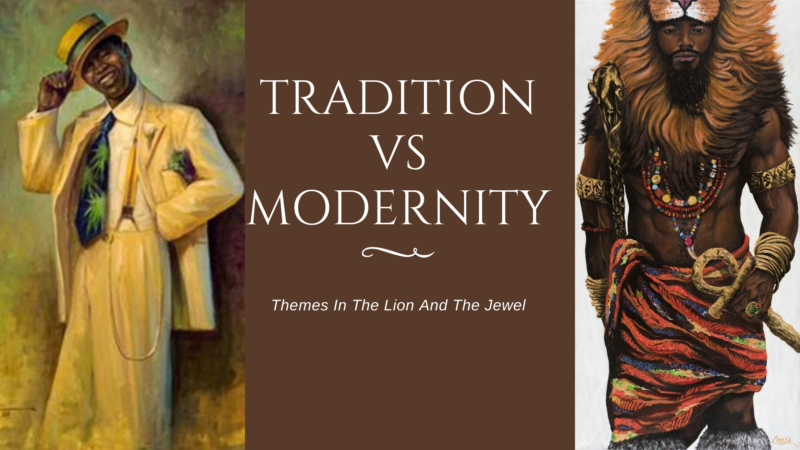
The Lion and the Jewel was written and performed in the year prior to when Nigeria was granted independence from Great Britain, and the script was published two years after the country’s independence. In this sense, one of the main conflicts in the play pits Yoruba traditions against western notions of modernity and advancement which is exemplified by the battle between Baroka and Lakunle over Sidi’s hand during the wedding.
Lakunle symbolizes the modern Nigerian man. He is dressed in western clothes and was educated at a likely British college, and he wants to make his village an oasis of modernity, similar to Lagos. Lakunle does not just admire western society but he also is adamantly and loudly against the traditions of his community and those who support them. This is evident in Lakunle’s insistence on not paying Sidi’s wedding price. Sidi says she’d be happy to marry Lakunle at any time, provided he would only pay the cost and follow the local tradition. Lakunle’s decision to not marry her proves that it’s much more important to him to change Sidi to his beliefs and make her a “modern wife” than it is to marry her first.
Through the course of the play, other characters talk about Baroka as being completely anti-modern and committed to conserving his village’s traditional way of living. Lakunle is the one who is disgusted by Baroka’s way of life. He recounts the way Baroka paid an official surveyor not to route trains through the outer reaches of Ilujinle and thus deprived the village of access to the world of modernity that could improve the quality of life in Ilujinle. But the moment Baroka is speaking, it is clear that he isn’t averse to modernity or the advancement of technology. Although he clearly enjoys the traditions and joys of life in the village, however, when it comes down to modernity, he hates being pushed into it. He is more interested in introducing modern practices to the village according to his preferences. For instance, he believes that the creation of an electronic system that is a part of the village could start to integrate it into the present without radically altering the traditional way of life in the village. Furthermore in his discussions about the modern concepts that were imposed on him, such as the union of his servants and taking Sundays off his tone is more resigned than angry. He sees it as a natural and irritating thing and not necessarily bad.
The battle between Baroka and Lakunle to win Sidi’s hand in marriage brings the tension between modernity and tradition to life. Baroka wishes to make Sidi one of his wife’s harem, while Lakunle is hoping to find a spouse who, theoretically at the very least, is his equal. Both men pledge Sidi an entirely different kind of strength and satisfaction. If Baroka passes away, Sidi will become the head wife of the new Bale which will create one of the most influential women in the village. Lakunle, on the contrary side, gives Sidi an opportunity to join an equality partnership where she isn’t required to be a wife as is the norm. However, the manner in which Lakunle speaks to and with Sidi suggests that agreeing to be married to Lakunle and adopting modernity may not necessarily mean that she’s better off because modern science gives Lakunle evidence that suggests that women are less strong and less educated than males. Sidi acknowledges that Lakunle’s vision of modernity may not be beneficial to her life. In actuality, it could result in her having lesser power and fewer rights than she has in a traditional marriage.
His actions (and how he wins the contest to win Sidi’s hand) suggest that although Lakunle could be right that Ilujinle does need to be a part of the world of modernity, modernization, and the utter refusal to adhere to local customs to do things are unwise goals that will not benefit anyone. The victory of Baroka indicates that progress should be made at the time and place it is beneficial to the people of the village.
MEN VS WOMEN-
Themes in The Lion and The Jewel
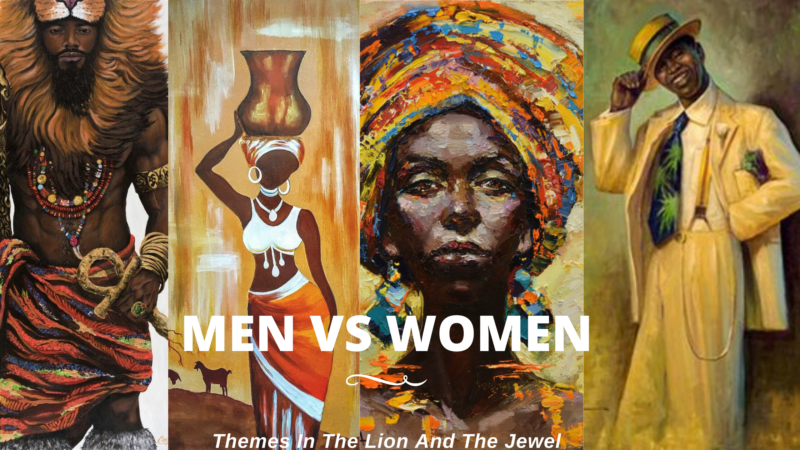
It isn’t clear if Soyinka is consciously trying to make a statement regarding gender However, he makes a statement. On one side, he has two female characters who are opinionated, sassy, and manipulative. They are also independent. However, both are basically pawns in games of men. Sidi doesn’t want to be married to Lakunle or Baroka however Baroka is a sly swindler, who rapes Sidi, after which she promises the chance to get married. She is a mere object and is nothing more. Sadiku is also deceived and she is shocked to see her excitement over Bale’s inability as well as the strength of females diminish as the plot of his evidence. Women might appear to have the power of mid-20th century Nigeria however, they don’t.
The Lion and the Jewel is a play about the contest to be the first to win Sidi‘s hand in marriage, which is what makes the play, in a way it’s a battle between both genders. The play raises many questions regarding the nature of the power of each gender that is why women and men have power; the process by which they gained power in the first place and how they maintain or lose the power.
The fighters for Sidi think of her as an exquisite prize that needs to be won. Baroka as well as Lakunle appreciate Sidi just for her beauty and virginity. In contrast, the men of The Lion and the Jewel are appreciated by others (and regard themselves) according to their abilities or what they have already accomplished. Lakunle for instance is valued as a scholar and is determined to bring education, modernity as well as Christianity to Ilujinle, and Baroka’s importance is derived from his position being the Bale Ilujinle and his responsibility to ensure his people’s safety and to build his image through having many wives and bringing up children.
For both Baroka as well as Lakunle, Sidi is a precious object that is that can be a nuisance and amuse the guys however, she is a valuable object. Lakunle is looking for Sidi to marry him so that they can perform better in modernity by getting a modern bride and one who is wearing shoes that are high and wears lipstick. In the same way, Baroka wants Sidi to be his wife and to complete the collection of his harem. Although it’s uncertain whether Baroka will fulfill his promise of Sidi as his last wife, she’ll be his heir to the crown of his wives. For both men marrying Sidi is a sign of status and an indication of their power, their virility, and the exemplary quality of their different styles of living (modern and traditional). Furthermore, the conclusion of the story suggests that the things Lakunle seeks to get from Sidi (a woman who is modern and can make him appear more contemporary) aren’t even a requirement for Sidi specifically. By shifting his focus to the next woman to dance in his direction, Lakunle suggests that although Sidi could be an attractive option, he could achieve his desire of having a modern spouse by marrying any woman who is up to the job. The play reduces women to mere objects that must be a part of the life of the spouses.
The notion of reducing individuals who have no power over objects is also reversed. If Sadiku believes in Baroka’s story that his masculinity (virility) has lost, she dances joyfully around the monument of Baroka and sings”Women have won” the battle against men. She is aware that Baroka’s position of authority within the village is linked to his capacity to perform sexually and bear children. She believes that once this particular power disappears then the other aspects powers he holds will disappear which will leave his wives (who remain capable of performing sexual acts and carrying children) triumphant. In this instance, when Baroka seems to have lost what grants his power, he’s diminished to being symbolized by a real thing (the sculpture). But the play indicates that there’s a gap between the weakness of Baroka being depicted by an object and the way women are considered objects. If Sadiku moves around the statue Baroka It is important to remember that she is not able to revel in her victory publicly. She is able to celebrate her victory in private and taunt an image of Baroka however, she can’t ridicule Baroka himself. On the other hand, Sidi, Sadiku, and the other female villager characters are taunted, teased, and mocked in them throughout the show. They’re snatched, adored as well as raped, and told they’re simple and backward due to the fact that they’re females. Male characters aren’t required to smirk at non-animate objects. Their cultural background, no matter the way they interact with the world of modernity or tradition, allows them to treat women as objects and treat them as such.
Pride, Vanity, and the Power of Images
As the village’s belle, Sidi is incredibly self-centered. She is aware that her worth is determined by her appearance and wastes not a moment in reminding the Lakunle along with the rest of the village that she’s gorgeous. But, when strangers take Sidi’s beauty in film and then return to Ilujinle with photos Sidi’s self-esteem increases exponentially. The photos show Sidi and the villager on the strength of pictures and the subsequent events of the play investigate the power that imagery can bring and its connection to pride and vanity.
When the man who was a stranger comes back to Ilujinle with the book of photos, Sidi deems herself more powerful than Baroka himself. This journal and the photos are evidence of her beauty and strength and show the potential of images in a variety of different ways. One of them is Sidi appears to not have looked at her reflection before. This is why seeing it in the newspaper is the very first moment Sidi is able to see her image for herself, instead of being able to interpret how other people view and judge her. This transforms Sidi into a Narcissus-like figure obsessed with her personal image. Although seeing her self-image lets her take control of her body and beauty, however, it blinds her from the reality that people as well are also trying to control her appearance and body. For instance, although Sidi may misinterpret the specifics of Baroka’s fascination for her, it’s clear that the magazine permits him to admire Sidi’s appearance without Sidi herself in the picture. This definitely influences his decision to seek her out as a wife.
In the time that the magazine is distributed to the town, Sidi isn’t the only character to be shown as self-centered and proud. The girls in the village are very clear even though Baroka is featured within the publication, it would have been better to be kept out of the magazine. The picture of him is small and shows him standing next to the latrine in the village. In the event that he only appears once in a tiny image as well as next in the bathroom, the power of Baroka is severely diminished. The ridicule of the village girls suggests Baroka’s image in a few ways, which diminishes Baroka’s power in actual life.
Sidi’s newfound confidence in power and beauty, coupled with Baroka’s dismal photo can lead Sidi to conclude that the marriage proposal is based on a desire to be in control of Sidi’s worth. Sidi isn’t lying but it cannot be denied that Baroka certainly wants to manage her worth and preserve her beauty to himself by getting Sidi as his wife. Baroka will also try to manage her worth by placing her picture on an official postal stamp–something that is mutually advantageous for both of them. When he puts Sidi’s picture on a stamp Baroka also appeals to her vanity and demonstrates the image’s power. This gives Sidi to take advantage of the recognition that the magazine has brought, as well as make her more famous and spread her image more. It is important to recognize that, while Sidi is sure to enjoy the recognition and fame which will result from this stamp. Fame and respect will be all she’ll ever get. Sidi won’t benefit from the power of the economy that comes from earnings, and she will not be acknowledged for having modernized the village through the development of an infrastructure for postal service. Baroka is likely to benefit from both of these since Baroka has the ultimate ability to influence Sidi’s image as well as, consequently, Sidi herself.
Theme Of Love and Marriage
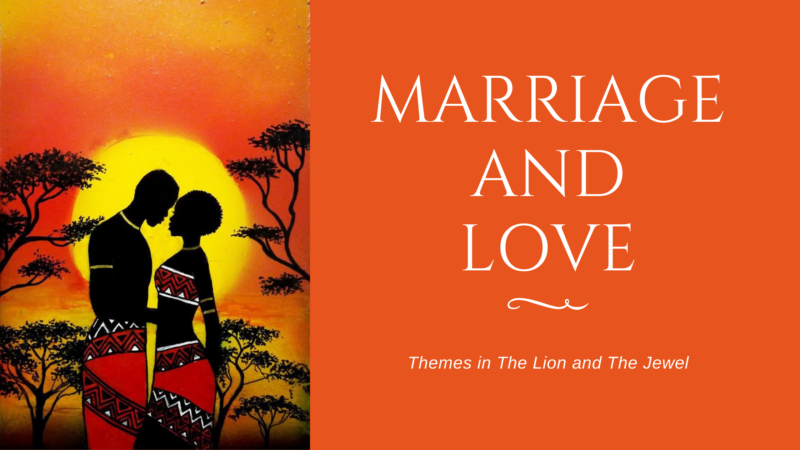
Sidi is the main point of attention in the play. Her attractive appearance makes her a favorite of the men of the village and, obviously, to the strangers. Baroka and Lakunle express their affection for Sidi in their individual ways.
The institution of marriage is prominently portrayed in the marriage institution The Lion and the Jewel. While Lakunle is hoping to get Sidi’s attention with his flowery words and his promises of a marriage that is fair, Baroka takes a more pragmatic approach to bring Sidi into his wife’s harem. At the end of the day, Sidi marries Baroka.
Deceit-
Themes in The Lion and The Jewel
The concept of deceit is manifested through Baroka. Baroka is lying to Sadiku by using a loose tongue, about his inability to do anything. Sadiku, in turn, shares the news of Baroka’s humiliation. It is based on the basis of this story Sidi Sidi decides to honor Baroka’s request to drink with Baroka.
Sidi wouldn’t have accepted Baroka’s request if she knew she was fooled. If she had then, she might not have been awed by Baroka’s sexual prowess and therefore, wouldn’t have gotten married to Baroka.
Let’s not put our hopes on the line. Baroka gets Sidi’s attention by trickery.
Virility and Cowardice-
Themes in The Lion and The Jewel
This is evident again in the comparison between the two masculine characters: Lakunle Baroka and Lakunle Baroka -but this time, not due to their theories but of their approach to Sidi. Both have different methods to win Sidi’s love. Lakunle attempts to woo Sidi and claims that he loves her. However, he isn’t ready to pay the bride’s price even though he would love to get married. Sidi who is aware of her femininity and dignity won’t marry Lakunle due to his refusal to pay the bride’s price.
Baroka however is willing to go to the lengths to get Sidi his even if it means he must be untruthful during the process. He will do anything to accomplish this. Even at the age of sixty-two, he shows strength and virility that Lakunle even in his 20s, can’t boast of.
Sidi praises Baroka for fulfilling his role as, “the Lion”, and also for being a genuine man. She refers to Lakunle as the “beardless version of unripened man”.
Language, Words, and Trickery
The Lion and the Jewel are full of examples of tricks, especially related to the language. Language is the instrument that characters use to fool each other to create false impressions of superiority and influence people to believe in their cause. This is why language is shown to be an instrument of power. However, the end of the story indicates that language is powerful when it is used without lying or deceit as well as when employed to accomplish specific realistic objectives.
Lakunle loves using large words and beautiful language in order at impressing Sidi as well as other villagers. While his proficiency in the English language can make him feel confident, however, it actually makes him appear to be an idiot. For instance when Lakunle refers to the practice of paying the bride’s cost by calling it “excommunicated” or “redundant,” it is evident to the audience Lakunle isn’t completely understanding of English despite the fact that he adores and boasts about the language. He employs complicated terms because he is aware that they’re beyond the comprehension of his fellow people. But, even though he believes that his language will be remarkable, Sidi tells Lakunle scornfully that his words “always sound the same/and make no meaning.” This implies that even the fact that Sidi isn’t aware of the fact that Lakunle is using words in a wrong way Lakunle’s performance exposes him as the fool he truly is and both the audience and the characters are laughing at him for it.
Lakunle’s efforts to win Sidi with the language she isn’t familiar with are only one of the many examples of characters who use tricks in order to accomplish their objectives. Sadiku And Sidi attempt to make Baroka look like a fool Baroka with the help of fooling him into believing Sidi is accepting his proposal of marriage, Baroka himself tricks both women into believing that his manhood is gone, and then is able to trick Sidi into getting married to him. The entire scheme is executed by the use of words which is a form of verbal manipulation instead of physical tricks. Although the effectiveness of these tricks differs from character to individual the fact that they are verbal indicates the effectiveness of words and language to manipulate others.
The play does, however, make the line between tricks intended to stimulate actions (like marriage or the modernization of the village) as well as techniques that are designed to provoke an emotional reaction like humiliation. Sadiku and Sidi’s effort to make Baroka look like a snob Baroka by exposing her inability to sexually perform (an emotional tactic) fails and both women appear as if they were fools. In the same way, while Lakunle’s primary goal was to persuade Sidi that he should marry her, Lakunle is to be more focused on creating a look that is sophisticated and contemporary. The tricks that have only motivational goals are only used for the purpose of making those who are performing the trick appear foolish. Baroka is, on the contrary, on the other hand, has a clear goal and uses a mix of tricks and telling the truth to accomplish these goals. A large portion of the information Baroka shares with Sidi appears to be true He doesn’t dislike the pace of change and, in actual the future, he wants to accelerate progress by creating an efficient postal system for the community. Through using truth for his benefit and setting fairly realistic and achievable objectives (marriage in Sidi and modernization, but in moderate amounts), Baroka is able to exert real influence over other people.
Performance –
Themes in The Lion and The Jewel
There are a variety of performances in the story, including dancing, singing, and acting. The characters, which includes Bale are involved in them. The performances are an integral aspect of Nigerian culture. They help identify, celebrate, and stress the aspects that are important to the population. It was a story popular, but the act made it a significant event in the time of the community. The mummers’ rendition of the fall of Bale and Sadiku’s involvement in it was an opportunity to voice their displeasure with the Bale’s leader. The show gives insignificant Sadiku the feeling of power, even though it’s really a fantasy and nothing more.
Legacies of Colonialism-
Themes in The Lion and The Jewel
Although Soyinka isn’t tackling this issue as clearly as his other works do in his other plays, the issues of imperialism and colonialism in Nigeria are present beneath the play’s surface. Lakunle symbolizes the West His clothes as well as his words, his knowledge, and his smugness all reflect the influence of Britain on Nigeria. Bale is a symbol of the West. Bale is a typical African figure who is aware that it is not possible to bury his head in sand. The mid-20th century Nigerian village he runs is affected by British rule. Even though Nigeria is on its way to independence (1960) however, it is not going to be able to return in the future. This is modern society and has to begin to evolve, regardless of whether it wishes to or not.
What other themes in The Lion and the Jewel did you discover? Tell us in the comment section below.
Now that you’re done with The themes in The Lion and The Jewel, let’s move to The Lion And The Jewel Characters
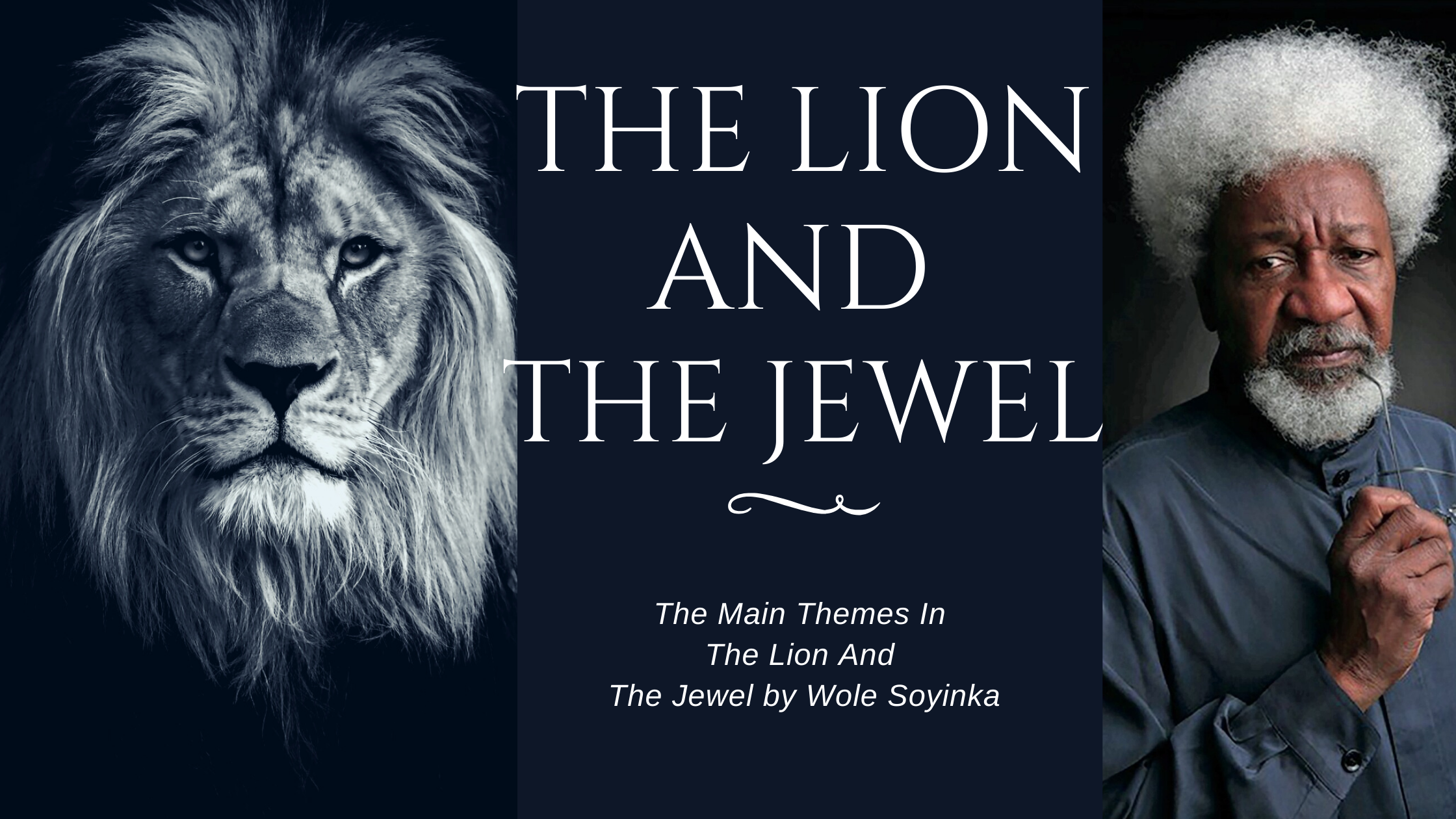

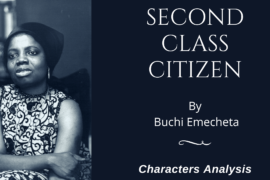
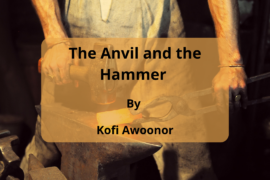
1 Comment
Pingback: Character Analysis of Lakunle in The Lion and The Jewel - SmartNib